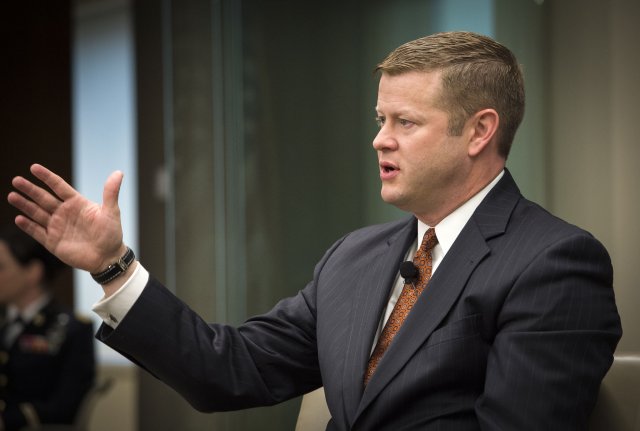
Ryan McCarthy
WASHINGTON: The Army is studying 30 cities as possible sites for the Futures Command it’s standing up this summer — but the winning city may hardly notice.
“It’s not going to be an 800-person command,” Army undersecretary Ryan McCarthy told reporters. The plan is to “lease….a couple floors in a high-rise, as opposed to a massive building that we own.” As technology and the economy changes, he added, the command may well need to move “10 to 15 years from now.”
The new HQ, he emphasized, needs to be small, unbureaucratic, and able to blend in to the hoodies-and-sneakers culture of civilian innovators from both the private sector and academe.
“We need them,” McCarthy said on the sidelines of the annual McAleese/Credit Suisse defense conference here. “We’re trying to get them excited about working with us, a culture that they don’t necessarily have an affinity to.” He recounted an awkward experience on a recent visit to Chicago to make an announcement about the Army Research Laboratory. McCarthy was in French cuffs and business suit, the Army officers were in their dress blues, and the local innovators were in their hoodies, staring at the Army delegation as if it came from Mars. The new Futures Command HQ must be able to bridge the gap between the two cultures.
This sounds a lot like Diu(X), the Pentagon’s embassy to Silicon Valley with outstations in Austin and Boston, one reporter said. “It has similarities,” McCarthy said. “They’ve done very well for themselves.”
So what uniforms — if any — should the officers at the new HQ be wearing day to day? McCarthy said he’d leave those details to the leadership of the still-forming Futures Command. But, he said, “I try to emphasize to them, you need to get in a big city. It’s more of a relaxed culture than you’d have at FORSCOM or TRADOC,” to name two massive Army headquarters.
TRADOC, Training & Doctrine Command, is going to get smaller as some of its subunits move to the new Futures Command along with elements of the Army science, technology, & acquisition bureaucracies. But McCarthy reiterated what Army leaders have been saying for months. The workforce will overwhelmingly stay where it is, it’ll just report to a new headquarters — a single unified command for all Army modernization as opposed to the current fragmented structure.
Even where the reform creates new structures, they’re often in old locations. The high-powered Cross Functional Teams (CFTs) working on the service’s Big Six modernization priorities, for instance, will probably end up on existing bases: the Long-Range Precision Fires CFT in the artillery center at Fort Sill, for example, or the Future Vertical Lift CFT in the aviation center at Fort Rucker.
But the top leadership of Futures Command needs to be embedded in the civilian innovation economy, Army leaders have decided. “We needed access to academia and business,” particularly talent in systems and software engineering, McCarthy said. That’s very different from the standard criteria the Army considers in basing decisions, and the number of Army personnel involved is much smaller. So, he told the McAleese conference, “we’ve had to develop a methodology with an outside firm, (a) formula (to) compute what would be the best location in the country.
The Army now has a list of 30 cities it’s trying to narrow down to 10 that it’ll actually visit — “conduct site reconnaissance” as McCarthy, an ex-Ranger, put it. Then they’ll winnow the 10 down to a final four and then ultimately the one winner.
“”It’s going to be somewhere the talent is,” McCarthy said.
Move over FARA: General Atomics pitching new Gray Eagle version for armed scout mission
General Atomics will also showcase its Mojave demonstrator for the first time during the Army Aviation Association of America conference in Denver, a company spokesman said.


























